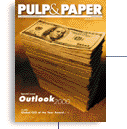
User perceptions: The real IT challenge
In Stanley Kubrick’s classic film, 2001: A Space Odyssey, H.A.L. the computer is the symbol of a world seduced by technology that insidiously controls our environment. It is a world that promises the ultimate in automation. It is also a world in which humans exert very little real control over technology.
Now, a little less than a year from Kubrick’s millennium, the paper industry is faced with old challenges that seem to have become endemic: over capacity and declining real prices. In addition, new threats exist that we have yet to figure out: shorter up cycles and longer down cycles; globalization; web-enabled commerce that promises customers real time information on pricing; and advanced printing technologies that threaten to shift value away from the paper we produce and toward the devices they sell.
In fact, what we make will probably become less important than how we take it to market. And, the velocity of change is rapidly increasing, fueled by information and communications technology that are moving so fast that they challenge comprehension.
THE APPEAL OF TECHNOLOGY. As we exhaust traditional productivity initiatives, we realize the economic drawback of increased production that goes into inventory or reduces market prices. Also, our ability to continue extracting value from our suppliers through reduced purchase price has limits—especially in fiber.
So, the appeal of the technology is tremendous, and it has drawn many paper companies into applying broad-based information technology (IT) for process optimization, supply chain management, and administrative efficiency. However, the reality is that this technology is complex, hard to install, and not seamless. It also creates a fundamental revolution in how we manage our business.
We have seldom invested in the infrastructure to support such applications and they are costly. In fact, the reality of these new technologies is so different from what we have built and managed in the past, we are often not up to the task.
PEOPLE: THE REAL CHALLENGE. I came to this industry from the information and publishing industries—not as a technologist, but as a marketer and manager of the products and services enabled by technology. I realize that information and communications technologies are simply tools, and my focus has been on the adoption of these tools as a way to achieve business benefit.
My role today, which is the deployment of an enterprise resource planning (ERP) system on a worldwide basis across the Mead Corp., is not much different from my previous experiences. The technology is more powerful and its capabilities are more robust. But, technology is still a tool. And while complex, the technology is not the most significant challenge.
The real challenge remains bridging technology and people for business benefit. How do we get people to accept process changes that they may not perceive as helpful to their role but which improves business efficiency? We must manage perceptions so that the user accepts the differences between what they are used to and what the new system demands. It is marketing— insuring that users understand the benefits we are investing for and not creating an environment where users look for "workarounds" so that nothing changes.
It’s not a new challenge. I remember a bank in the early 1980s that introduced e-mail. Resistance was high—executives viewed keyboard skills as clerical. However, a small group was elected to be the first to use the technology. Instead of a stigma, e-mail became a status symbol and soon everyone wanted it. A technology challenge? No, a people challenge that was solved though a careful analysis of overcoming human barriers.
I suggest that we become as proficient in dealing with the human side of change as we are on the technology side. It is an IT challenge as well as a business leadership challenge, but IT is in the middle of it. IT bridges the gap between the business side and the technology side, and we must expand the equation to the people side.
We are not always skilled in this area. Our industry has honed its skills around definable issues with fact based solutions. Our paper machines run on schedule and we are proud of that, but the industry’s future relies on people working together across the enterprise to solve problems on a real time basis.
Since technology is the factor that most people perceive to create this atmosphere, we must take the time to internalize the people side, and then apply what we know about the business and technology side. By doing so, we will create value for ourselves, our employees, and our shareholders.

|





